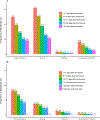Use of electronic health record data to examine administrations of pro re nata analgesics during hip fracture post-acute care
- PMID: 38825963
- PMCID: PMC11149906
- DOI: 10.1002/pds.5846
Use of electronic health record data to examine administrations of pro re nata analgesics during hip fracture post-acute care
Abstract
Purpose: Medications prescribed to older adults in US skilled nursing facilities (SNF) and administrations of pro re nata (PRN) "as needed" medications are unobservable in Medicare insurance claims. There is an ongoing deficit in our understanding of medication use during post-acute care. Using SNF electronic health record (EHR) datasets, including medication orders and barcode medication administration records, we described patterns of PRN analgesic prescribing and administrations among SNF residents with hip fracture.
Methods: Eligible participants resided in SNFs owned by 11 chains, had a diagnosis of hip fracture between January 1, 2018 to August 2, 2021, and received at least one administration of an analgesic medication in the 100 days after the hip fracture. We described the scheduling of analgesics, the proportion of available PRN doses administered, and the proportion of days with at least one PRN analgesic administration.
Results: Among 24 038 residents, 57.3% had orders for PRN acetaminophen, 67.4% PRN opioids, 4.2% PRN non-steroidal anti-inflammatory drugs, and 18.6% PRN combination products. The median proportion of available PRN doses administered per drug was 3%-50% and the median proportion of days where one or more doses of an ordered PRN analgesic was administered was 25%-75%. Results differed by analgesic class and the number of administrations ordered per day.
Conclusions: EHRs can be leveraged to ascertain precise analgesic exposures during SNF stays. Future pharmacoepidemiology studies should consider linking SNF EHRs to insurance claims to construct a longitudinal history of medication use and healthcare utilization prior to and during episodes of SNF care.
Keywords: analgesics; hip fractures; opioid; rehabilitation; skilled nursing facilities.
© 2024 John Wiley & Sons Ltd.
Conflict of interest statement
A.R.Z received prior grant funding paid directly to Brown
University for collaborative research on the epidemiology of infections and vaccine use among nursing home residents. K.N.H. has received grant funding paid directly to Brown University for collaborative research from Insight Therapeutics, Sanofi, and Genentech for research on complex insulin regimens and influenza outbreak control in nursing homes. K.N.H. has also served as a consultant for the Canadian Agency for Drugs and Technologies in Health. The other authors declare that they have no competing interests relevant to the subject matter of the manuscript.
Figures





Similar articles
-
Analgesic regimens administered to older adults receiving skilled nursing facility care following hip fracture: a proof-of-concept federated analysis.BMC Geriatr. 2024 Oct 30;24(1):897. doi: 10.1186/s12877-024-05486-0. BMC Geriatr. 2024. PMID: 39478461 Free PMC article.
-
Comparing post-acute rehabilitation use, length of stay, and outcomes experienced by Medicare fee-for-service and Medicare Advantage beneficiaries with hip fracture in the United States: A secondary analysis of administrative data.PLoS Med. 2018 Jun 26;15(6):e1002592. doi: 10.1371/journal.pmed.1002592. eCollection 2018 Jun. PLoS Med. 2018. PMID: 29944655 Free PMC article.
-
Effect of Obesity on Postacute Outcomes of Skilled Nursing Facility Residents with Hip Fracture.J Am Geriatr Soc. 2018 Jul;66(6):1108-1114. doi: 10.1111/jgs.15334. Epub 2018 Apr 3. J Am Geriatr Soc. 2018. PMID: 29616500 Free PMC article.
-
Pro Re Nata Drug Use in Nursing Home Residents: A Systematic Review.J Am Med Dir Assoc. 2019 Mar;20(3):287-293.e7. doi: 10.1016/j.jamda.2018.10.024. Epub 2018 Dec 11. J Am Med Dir Assoc. 2019. PMID: 30551948
-
Identifying Residents Who May Benefit from an Analgesic Review: Applying Analgesic Indicators in Residential Aged Care Services.Drugs Aging. 2023 May;40(5):449-459. doi: 10.1007/s40266-023-01025-5. Epub 2023 May 6. Drugs Aging. 2023. PMID: 37147416 Free PMC article. Review.
References
-
- HCUPnet. Healthcare Cost and Utilization Project (HCUP). Agency for Healthcare Research and Quality. Accessed 23 June 2022, https://hcupnet.ahrq.gov/#setup - PubMed
-
- Reyes BJ, Mendelson DA, Mujahid N, et al. Postacute Management of Older Adults Suffering an Osteoporotic Hip Fracture: A Consensus Statement From the International Geriatric Fracture Society. Geriatr Orthop Surg Rehabil. 2020;11:2151459320935100. doi:10.1177/2151459320935100 - DOI
Publication types
MeSH terms
Substances
Grants and funding
LinkOut - more resources
Full Text Sources
Medical

